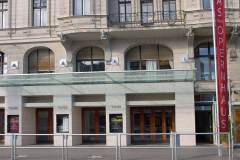Ascanio in Alba
March 2026 | ||||||
|---|---|---|---|---|---|---|
Mo | Tu | We | Th | Fr | Sa | Su |
Concert performance in Italian with German surtitles
Introduction to the work 30 minutes before curtain-up
SERENATA TEATRALE IN TWO ACTS
LIBRETTO BY GIUSEPPE PARINI
Wolfgang Amadeus Mozart was 15 years old when, in 1771, he composed his serenataAscanio in Alba for the wedding of Archduke Ferdinand and Princess Maria Beatrice d’Este in Milan. The work is a typical allegory, portraying Empress Maria Theresa, the Archduke’s mother, as Venus, goddess of love, who brings her son Ascanio together with the wife that is right for him. The young Mozart’s music, with its numerous choruses and arias in the style of opera seria, was very well received by the wedding guests and the marriage of the prince and princess was to be a happy one. The collaboration that has existed for many years between Christophe Rousset with his ensemble Les Talens Lyriques and the MusikTheater an der Wien is also extremely harmonious. For Mozart’s Ascanio in Alba he brings top-class singers with him such as the sopranos Anna El-Kashem and Rocío Pérez, tenor Alasdair Kent, and Mélissa Petit who most recently appeared at the MusikTheater an der Wien as the eponymous heroine in Roméo et Juliette.
Synopsis
Place: the site of the future city of Alba Longa, near Rome
Time: mythical times.
Part 1
The opening scene introduces Venus and Ascanio, the son she had by Aeneas. (In most classical sources, Venus/Aphrodite is the mother of Aeneas.) The goddess vaunts the charms of Alba and invites her son to go and rule there. She urges him not to reveal his identity to Silvia, a nymph to whom he is betrothed, but to introduce himself to her under a false identity to test her virtue. While shepherds summon their promised ruler, Fauno reveals that the smiling face of Aceste, a priest, is a sign that the day will be a day of supreme happiness. Obeying the goddess, Ascanio pretends to be a foreigner attracted by the beauties of the place. Aceste tells the shepherds that their valley will be the site of a fine city and that they will have a sovereign, Ascanio, before the day is out. He also informs Silvia that she will be Ascanio's bride, but she replies that she is in love with a young man she has seen in a dream. The priest reassures her, saying the young man in her dream can be none other than Ascanio. Venus then appears to Ascanio and asks him to test the girl a little longer before revealing his true identity.
Part 2
Ascanio spots Silvia among the shepherds and tries to talk to her. The girl immediately recognizes the young man from her dreams. Fauno intervenes and suggests to “the foreigner” (Ascanio) that he should go off and announce the building of Alba in foreign parts. Thus convinced that the foreigner is not Ascanio, Silvia is deeply saddened. She finally decides to accept her fate but declares she never will love anyone else than Ascanio.
Aceste consoles Silvia, saying that her tribulations are about to come to an end. Venus is invoked by a magnificent chorus. Silvia and Ascanio add their voices to the chorus and the goddess descends on her chariot surrounded by clouds. Venus unites the two lovers and explains how she had intended her son to discover the virtue of his fiancée. Aceste pronounces an oath of fidelity and loyalty to Venus, who then retires. It only remains for Ascanio to perpetuate the race of Aeneas and guide the city of Alba to prosperity.
Program and cast
Conductor: Christophe Rousset
Venere: Mélissa Petit
Ascanio: Alisa Kolosova
Silvia: Anna El-Khashem
Aceste: Alasdair Kent
Fauno: Rocío Pérez
Les Talens Lyriques
Arnold Schoenberg Chor (Conductor: Erwin Ortner)
Theater an der Wien
About the Theater an der Wien
The New Opera House is not just any theatre, but the one that Emanuel Schikaneder, the all-round genius, actor, impresario with a flair for organization but above all librettist of The Magic Flute, had built in 1801 in Vienna in keeping with the spirit of Mozart.
To coincide with the 250th anniversary of Mozart’s birth the Theater an der Wien presents itself as a new opera house from January 2006. As a “season” opera house with productions all the year round the Theater an der Wien carves a new and independent niche in the realm of high-quality culture in Vienna. For twelve months of the year, with one premiere every month, opera will be performed under the “stagione”, or season, system: that means the cast remains unchanged from the first performance to the last one, which guarantees that the very highest international standards are maintained.
The theatre’s modern, accessible approach to music theatre as demonstrated by the works performed, the overall artistic concept Bespielung and the artistes is further underlined by the building itself, its architecture and the vibrancy of its location. The surroundings and materials, the intimate atmosphere and perfect acoustics in the historical theatre prepare the senses to experience beauty. The Theater an der Wien deliberately enters into a symbiotic relationship with its lively surroundings on the Naschmarkt street market and the young cultural scene centred in the Schleifmühl quarter.
How to get there
With public transport:
We can be reached by public transport:
U1, U2 und U4 Station Karlsplatz, Exit Secession
Bus 59A Station Bärenmühldurchgang
Bus 57A Station Laimgrubengasse, pedestrians via Laimgrubengasse to Linke Wienzeile
KAMMEROPER:
Fleischmarkt 24, 1010 Wien
We can be reached by public transport:
U1, U4: Station Schwedenplatz
Tram Linie D (bei Ablenukung über Kai), 1, 2: Station Schwedenplatz
Bus 3A (on workdays)

 EN
EN DE
DE IT
IT FR
FR ES
ES RU
RU JP
JP RO
RO
 Seating plan
Seating plan 